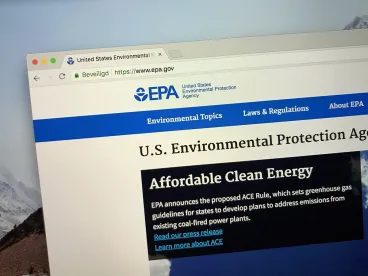Last week, the US Environmental Protection Agency (EPA) announced the results of its enforcement and compliance efforts for the federal government’s 2021 fiscal year (FY2021)—October 2020 through September 2021. Prepared by EPA’s Office of Enforcement and Compliance Assurance (OECA), the report offers the first high-level look at the EPA’s enforcement of environmental laws under the Biden Administration. “Coming off a challenging few years,” said EPA’s Acting Assistant Administrator for OECA, Larry Starfield, “these 2021 results make clear that rigorous enforcement is back at EPA.” Key metrics in the report appear consistent with that message.
EPA FY2021 Trends and Data
Criminal Cases
EPA’s criminal enforcement was reportedly down by most metrics in FY2021: cases opened were down from over 200 in FY2020 to a little more than 100 in FY2021; years of incarceration sentenced were down slightly from around 50 in FY2020; and the number of defendants charged remained fairly steady, with FY2021 at just over 100. Currently, criminal fines, restitution, and court-ordered projects are at a record low, falling millions short of comparable prior years (those with no sizeable, single-case anomalies). To some, this may seem somewhat surprising given the Administration’s pronounced reinstatements of vigorous criminal enforcement coming out of the Justice Department, including from the Assistant Attorney General for the Environment and Natural Resources Division and from the long-serving Chief of the Environmental Crimes Section. In reality, though, it is too soon to read much into these figures, which represent less than a year of the new Administration, for a variety of reasons. First, EPA’s report explains the continued “negative[] impact” of the COVID-19 pandemic, including “fewer civil inspections that lead to criminal case referrals and restrictions on judicial processes.” Second, because significant time and resources are necessary to mount criminal cases, the Administration’s pledged increased focus on corporate crime may still materialize. Criminal cases can take multiple years to investigate, prosecute, and reach resolution, so the low figures for fines and other relief this year are more reflective of the pipeline of cases inherited from the past administration.
Civil Cases
EPA initiated and concluded roughly 1,600 civil judicial and administrative cases in 2021. This is about level with FY2020; however, FY2021 continues a steady, declining trend over the last decade. In 2011, civil enforcement case initiations and conclusions topped 3,000. This year’s civil case results may also be affected by COVID-19 considerations, so may not necessarily be indicative of future enforcement under this Administration. Additionally, the number may reflect a certain amount of delay in enforcement action initiation and conclusion attributable to the change in administration, which could have created a slowdown near the end of the last administration and the beginning of the Biden Administration due to things such as gaps in management at the agency, leaving enforcement decisionmakers to cover multiple roles. The percentage of civil enforcement actions taken at facilities in areas of potential environmental justice concern in FY2021, too, has remained at the FY2020 level. The agency expects this “proportion to increase in FY 2022” because of its “plans to increase its focus on non-compliance in such areas.”
Civil Penalties
EPA assessed more than $1 billion in administrative and civil judicial penalties, the highest number since FY2017, which saw $1.8 billion. As the Agency’s report notes, penalty metrics typically hinge on one or two significant cases that dominate the annual total. FY2021 marked the highest penalty total EPA has recorded, however, for cases at facilities in areas of potential environmental justice concern. Notably, this is a new metric included in EPA’s annual report for the first time this year.
Injunctive Relief
The cost of injunctive relief EPA required from companies in resolution of enforcement actions marked a significant increase from the prior three years but remains at or below the injunctive relief totals during the Obama administration. For FY2021, injunctive relief totaled nearly $8.5 billion, compared to an average of $3.8 billion from FY2018 to FY2020. FY2021 includes, in part, injunctive relief in three significant settlements with the City of Houston, New York City, and Dekalb County, Georgia. As with the overall case numbers discussed above, at least some of the injunctive relief for FY2021 stems from actions initiated during the prior administration. For instance, $2 billion accounted for in the FY2021 injunctive relief figure resulted from a Clean Water Act settlement with the City of Houston that was approved by the court in April 2021, but Houston and EPA had entered into that agreement in 2019. For the first time, however, EPA reported injunctive relief values in areas of potential environmental justice concern. For FY2021, that totaled roughly $2.4 billion, based on cases with at least one facility in an area of potential environmental justice concern, which the agency represents as a nearly eight-fold increase over last year and significantly higher than all years since FY2014, the first year for which EPA had environmental justice data.
Environmental Benefits from Cleanup
EPA secured facility commitments to treat, minimize, or properly dispose of more than 7.5 billion pounds of hazardous and non-hazardous waste, the largest amount by far since 2016. EPA also obtained commitments for roughly 22 million cubic yards of contaminated soil and water to be cleaned up. This metric decreased significantly from last year’s more than 105 million cubic yard total and, other than 2019 (which came in at just shy of 13 million cubic yards), represented the lowest annual total in a decade.
Inspections
EPA completed more than 3,200 inspections in FY2021; a slight increase over last year’s 3,000 inspections but still a significant reduction from prior years. For example, EPA conducted roughly 8,000 in FY2019. EPA explains: “During FY 2020 and FY 2021, the COVID-19 public health emergency severely constrained EPA’s ability to perform on-site inspections in the field.” As in FY2020, the ongoing pandemic continues to affect in-person activities in FY2021, with increased safety measures, quarantine requirements, and staffing shortages, all of which play a factor in on-site inspections. On-site inspections may increase in the coming years based on the evolution of COVID-based restrictions and EPA’s December 2021 decision to rescind 40 C.F.R. Part 31, promulgated under the prior administration to establish procedural policies and requirements for on-site civil inspections to allow for increased flexibility in conducting inspections. The agency does not cite the implementation of 40 C.F.R. Part 31, however, as a reason for the FY2021 decline in on-site inspections. As we have noted previously, EPA has reported a steady decline in inspections overall since 2014, well before the public health emergency’s impact on in-person interactions. This year, however, EPA reported a substantial increase in off-site compliance monitoring activities, marking an uptick in overall compliance monitoring activities for the first time in years.
Environmental Justice and Climate Change
As anticipated, the annual report looks at the agency’s enforcement efforts to further its environmental justice goals. Among other efforts, EPA touts its “swift action” taken “[i]n communities that faced acute threats to human health from environmental pollutants or contaminated drinking water,” including issuing a pair of Clean Air Act Section 303 emergency orders—a tool rarely used by the agency—to address concerns associated with facilities’ air emissions as well as a myriad of drinking water violation orders in communities with environmental justice concerns. Notably, the annual report is issued by OECA so it does not capture complaints submitted pursuant to Title VI of the Civil Rights Act because such petitions are handled by EPA’s External Civil Rights Compliance Office, which resides outside of OECA in the agency’s Office of General Counsel.
As part of its climate-related enforcement highlights, EPA underscored its 2021 final rulemaking under the American Innovation and Manufacturing Act (AIM Act) of 2020 to prevent the illegal trade, production, use, or sale of climate-damaging hydrofluorocarbons (HFCs). EPA’s HFC-focused enforcement efforts were announced on the heels of the 2021 UN Climate Change Conference (COP26) in Glasgow, where countries negotiated a global phasedown of HFCs aiming to avoid as much as 0.5°C of global warming by 2100.
The annual report’s focus on enforcement in the areas of environmental justice and climate tracks with EPA’s priorities announced in its Draft Strategic Plan for Fiscal Years 2022-2026, which is set to be finalized next month. In that draft, EPA added for the first time a pair of “strategic goals and emphasis to embed in all EPA work” focused on climate and environmental justice to its Strategic Plan.
The annual report also highlights enforcement activities that advance EPA’s FY2020-FY2023 National Compliance Initiatives (NCIs), which focus on the most serious environmental violations, such as air emissions, drinking water standards, accidental chemical and toxics releases, and water pollution.
COVID Response
The agency’s COVID response enforcement efforts may be lesser known to the general public. In its report, EPA provides insights into its enforcement and compliance advisory work associated with the ongoing pandemic—in large part relating to its response to fraudulent product claims under Federal Insecticide, Fungicide and Rodenticide Act (FIFRA), which applies to pesticides. Opportunists that sought to take advantage of the public health emergency by making and selling false or misleading disinfectant products to the public and businesses faced the agency’s COVID-19 Fraud Initiative. In total, EPA brought 617 civil enforcement actions and nine criminal cases in FY2021, under an initiative that will continue into the future.
Takeaways
The year-end results from the first year of the Biden Administration—taken together with President Biden’s Executive Order 14008; EPA Administrator Michael S. Regan’s directives to strengthen enforcement, particularly in areas with environmental justice concerns; and similar statements from, and a series of memoranda issued by, Acting OECA Chief Starfield on prioritizing enforcement that benefits underserved and overburdened communities and revitalizing criminal enforcement effort—indicate a “vigorous enforcement and compliance program” with a particular focus on environmental justice, air emissions, and criminal prosecution in coming years. That said, it is still too early to forecast the Biden Administration’s enforcement trends. Key enforcement positions within the agency are still yet to be filled, and civil and criminal cases, for instance, rely on enforcement groundwork that has been hampered in recent years due to COVID-19, among other things. The statistics are liable to change in the coming years as EPA sorts out how to balance COVID-related issues with on-site inspections. Thus, it is as important as ever for companies to maintain robust and proactive efforts to comply with all federal environmental laws, particularly if they have the potential to impact communities with environmental justice concerns.






 />i
/>i
